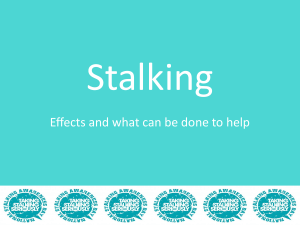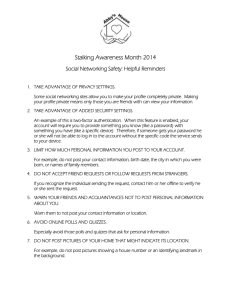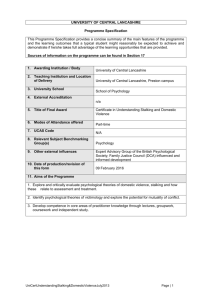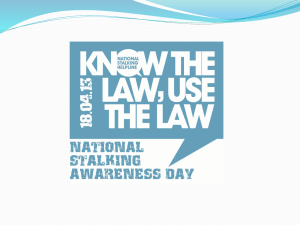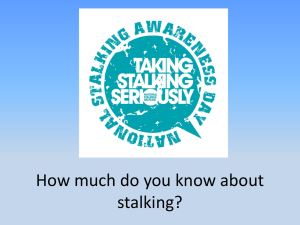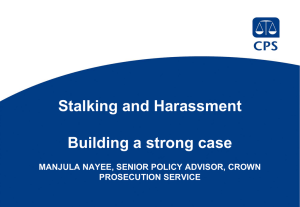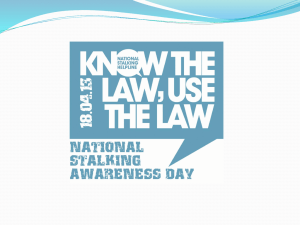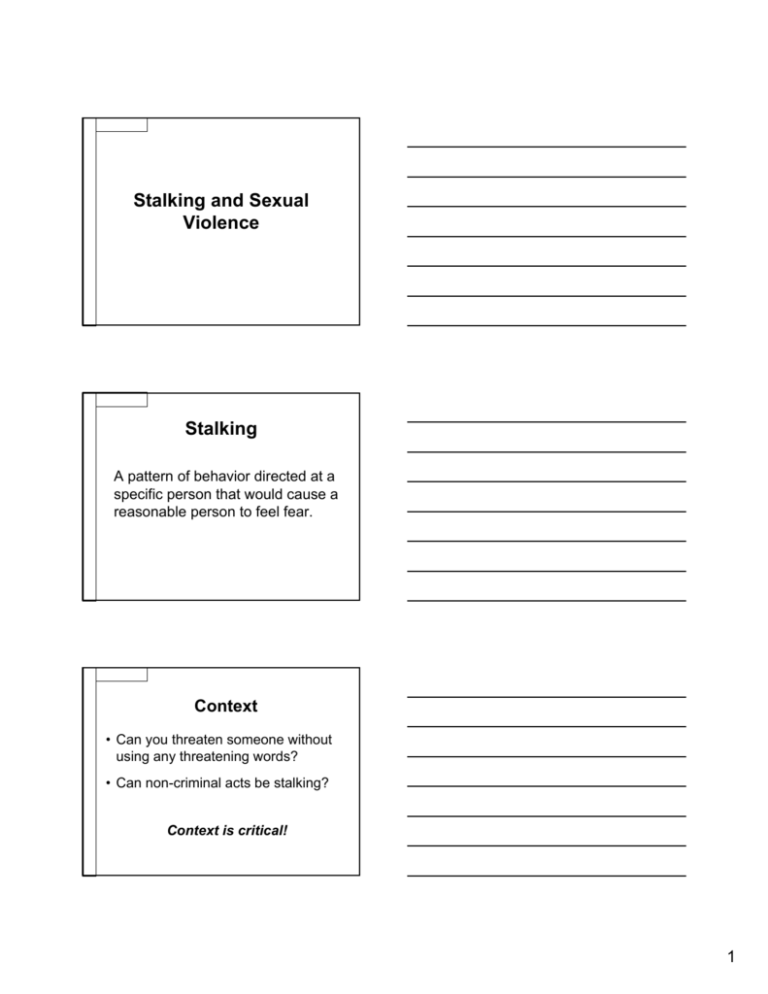
Stalking and Sexual
Violence
Stalking
A pattern of behavior directed at a
specific person that would cause a
reasonable person to feel fear.
Context
• Can you threaten someone without
using any threatening words?
• Can non-criminal acts be stalking?
Context is critical!
1
Prevalence of Stalking
3.4 million people stalked annually
• Persons aged 18-24 experienced the highest
rates of stalking victimization
• Nearly half experienced at least 1 unwanted
contact per week
–- Stalking Victimization in the United States, BJS (2009)
Gender of Stalking Victim
Females are nearly 3 times more likely to
experience stalking than males
7 per 1000 males age 18 and over
20 per 1000 females age 18 and over
Victims and Offenders
• Nearly 75% of victims know their offender in
some capacity
– 22% - former intimate
– 16% - friend, roommate, or neighbor
• Nearly 1/10th of all victims were stalked by a
stranger
–- Stalking Victimization in the United States, BJS (2009)
2
Impact on Victims
• Afraid of:
– 46% not knowing what would happen next
– 29% behavior would never stop
– 9% death
• 1 in 8 of employed victims lost time from
work
– More than half lost 5 days or more
–- Stalking Victimization in the United States, BJS (2009)
Stalkers
Profiles
THERE ARE NO DEFINITIVE
PROFILES OF STALKERS!
3
Stalker Typologies
• Multiple typologies – ranging from 3 to 12
• Can be helpful, but are only general classifications
• Individual stalkers may not precisely fit any single
category, and often exhibit characteristics associated
with more than one category
–
–
–
–
Simple obsessional
Love
Erotomania
False victimization
syndrome
– Intimate
– Nonintimate
o Organized
o Delusional
Demographics
Criminal History:
• 27% had no priors
• 33% had prior adult violent criminal history
• 19% had prior adult non-violent criminal
record
The RECON Typology of Stalking, Mohandie et al (2006)
Demographics
• 46% of offenders had a clear or probable
DSM-IV-TR diagnosis at time of stalking;
30% had none
• Substance abuse present in 32% of
cases
• Suicidal ideation present in 25% of cases
The RECON Typology of Stalking, Mohandie et al (2006)
4
Pattern of Behavior
• 2/3 of stalkers pursue their victim at least
once per week
• 78% of stalkers use more than one
means of approach
• Weapons used to harm or threaten
victims in about 20% of cases
- The RECON Typology of Stalking
- The RECON Typology of Stalking (2006)
Stalking Behaviors
unwanted phone calls and messages
66%
spreading rumors
36%
following or spying
34%
unwanted letters and email
31%
showing up at places
31%
waiting for victim
29%
leaving unwanted presents
12%
0% 10% 20% 30% 40% 50% 60% 70%
–- Stalking Victimization in the United States, BJS (2009)
Stalking Behaviors
Threatened to commit suicide.
7.0%
9.0%
Threatened to hurt or kill family members.
Threatened to report respondent to CPS or other authorities if demands
were not met.
10.2%
11.7%
Threatened while driving a car.
12.5%
Threatened to hurt or kill.
Threatened to report respondent to police for something that did not
occur.
16.4%
20.3%
Person came to the home or work place and created a disturbance.
Broke into the house, car, or buisness.
Unwanted contact because someone was waiting around outside the
home, work, etc.
Car was tampered with.
Stole items from house, car or business.
3.9%
21.1%
22.7%
34.4%
- Stalking in Texas (2007)
5
Stalking Behaviors
Threatened to commit suicide.
Threatened to hurt or kill family members.
Threatened
to report respondents to
7.0%
CPS or other authorities if demands
were not met. (10.2%)
9.0%
Threatened to report respondent to CPS or other
authorities if demands were not met.
10.2%
Threatened while driving a car.
Threatened to hurt or kill.
Threatened to report respondent to police for something
that did not occur.
11.7%
Threatened
to report to police for
12.5%
something that did not occur.
(16.4%)
16.4%
Person came to the home or work place and created a
disturbance.
Broke into the house, car, or buisness.
20.3%
3.9%
Unwanted contact because someone was waiting around
outside the home, work, etc.
Car was tampered with.
21.1%
22.7%
Stole items from house, car or business.
34.4%
- Stalking in Texas (2007)
Use of Technology to Stalk
More than 1 in 4 victims reported some
form of technology used
– 83% email
– 35% instant messaging (IM)
– 7% electronic monitoring of some kind
–- Stalking Victimization in the United States, BJS (2009)
Why do they stalk?
• Seeking Affection
• Rejection
• Obsession
• Power & Control
• Sexual Gratification
• Planning to commit a crime
• Because they can
6
7
“The Stalker” e-card
www.americangreetings.com
Stalking and Intimate Partner
Violence
8
Relationship Between Victim and
Offender
Current or former intimate partner
(spouse, boy/girlfriend)
30%
Friend/roommate/neighbor
16%
Acquaintance
10%
Known from work or school
10%
Stranger
10%
Relative
9%
0%
5%
10%
15%
20%
25%
30%
35%
–- Stalking Victimization in the United States, BJS (2009)
81% of stalking victims who were
stalked by an intimate partner
reported that they had also been
physically assaulted by that
partner.
- National Violence Against Women Survey (1998)
Point in Intimate Relationship When Stalking
of Women Occurs
After rel atio nship ends 43%
Before r el ati onshi p end s 21%
Before & after relatio nsh ip en ds 36%
9
Intimate Partner Stalkers:
Increased Risk for Victims
• More likely to physically approach victim
• More insulting, interfering and
threatening
• More likely to use weapons
• Behaviors more likely to escalate quickly
• More likely to re-offend
- The RECON Typology of Stalking (2006)
Stalking Violence
36% of women stalked by former
romantic partners experienced
stalking violence
– any physical attack on the victim by the
stalker that resulted in physical injury to the
victim or that was interpreted by the victim
as being intended to result in physical injury
- Women’s Experience of Violence During Stalking by Former Romantic Partners (2005)
Stalking Violence
• Greatest risk of violence is when the
stalker:
– issued direct threats of violence
– was jealous of the victim’s relationships with
others during the relationship
– user of illegal drugs
• Where there is evidence of the presence
of all of these factors, the risk of stalking
violence is heightened.
- Women’s Experience of Violence During Stalking by Former Romantic Partners (2005)
10
Lethality
• 76% of femicide cases involved at least
one episode of stalking within 12 months
prior to the murder.
• 85% of attempted femicide cases
involved at least one episode of stalking
within 12 months prior to the attempted
murder.
- Femicide Study (1999)
Lethality
• 67% of femicide victims had been
physically abused by their intimate partner
in the 12 months before the murder.
– 89% of those victims had also been
stalked in the 12 months before the
murder.
- Femicide Study (1999)
+
=
Physical Abuse
Stalking
Higher indicator of lethality
than either behavior alone
11
The Intersection of Stalking
and Sexual Assault
Prevalence of Sexual Assault
• Almost 18%, or 17.7 million women, in the
United States have been victims of rape or
attempted rape sometime in their lives.
- National Violence Against Women Survey (1998)
• In a 2005 survey of 600 women and men,
ages 16-24, six in 10 say that they know a
woman who has been sexually assaulted.
- Anti-Violence Youth and Young Adult Survey (2005)
• An estimated 248,300 individuals were
raped or sexually assaulted in 2007
- The National Crime Victimization Survey (2007)
Stalking and Sexual Assault
• 2% of stalking victims were
raped/sexually assaulted by their stalker
- Stalking Victimization in the United States, BJS (2009)
• 31% of women stalked by her intimate
partner were also sexually assaulted by
that partner
- National Violence Against Women Survey, Tjaden & Thoennes (1998)
12
Stalking and Sexual Assault on
Campus
• In 10.3% of campus stalking incidents, the
victim reported that the stalker forced or
attempted sexual contact
- National Sexual Victimization of College Women (2000)
• 3/4 of women who experienced stalkingrelated behaviors experienced other forms of
victimization (sexual, physical, or both)
– Stalking and rape/sexual assault only 26%
– Stalking, physical and rape/sexual assault 11%
- Stalking acknowledgement and reporting among college women experiencing intrusive behaviors (2007)
Premeditation and Stalking
• What does premeditate mean?
• How might someone premeditate a
sexual assault?
• Can premeditation = stalking?
“Nondomestic Organized Stalker”
Case example from A Typology of Interpersonal Stalking; Journal
of Interpersonal Violence, Vol. 11, No. 4, December 1996.
•Journal article discusses what they call the
nondomestic organized stalker”.
•Victim is unlikely to know she is being stalked
by this person until stalker chooses to let her
know.
13
“Nondomestic Organized Stalker”
• A man who was stalking a woman was arrested
outside her apartment after she observed him &
called police.
• Woman recently found her bathing suit taped to
windshield of her car.
• On another occasion, she found some of her
undergarments draped on the car’s mirror.
• 1 week prior to the arrest, the victim found
cartridge casings from a handgun taped to her
car’s window.
“Nondomestic Organized Stalker”
• Stalker was found sitting in his car less
than 100 yards from victim’s apartment.
• He was carrying:
– Knife
– Key to woman’s apartment
“Nondomestic Organized Stalker”
In his car they also found:
– .22 caliber pistol &
ammunition
– Stun gun
– Mace
– Camera & film
– 2 sets of binoculars
– 2 tape recorders
– 2 flashlights
– Pictures of victim’s
apartment & car
–
–
–
–
–
–
–
–
–
Rubber gloves
Cotton gloves
Stocking mask
Large nylon bag
Bag w/ change of
clothing
Several condoms
Book of nude pictures
Gun cleaning kit
Cooler filled with ice &
beer
14
“Nondomestic Organized Stalker”
• Months prior to this incident the offender
was acquitted of burglarizing the
woman’s home.
• What do you think he was planning to
do?
• Is “nondomestic organized stalker“
another way of saying rapist?
What kind of
rape do you
have to
commit to
end up in a
place like
this?
Common Societal Beliefs About
Rapists?
•
•
•
•
•
Ski mask
Knife
Blitz attack
Brutal injuries
Strangers
15
FBI Research
• Interviews with convicted rapists in prison
• General pattern for rape:
– Targeted women
– Watched them over time
– Waited for opportunity when woman was
vulnerable
• Is this stalking?
FBI Research
• Appearance and/or dress of victim was
virtually never a factor in how or why the rapist
picked his victim.
• Rapists picked victims based on observation
(voyeurism).
• Rapists essentially were stalking several
women at a time… waiting for an opportunity.
The Rape Paradox
16
Millions of victims…
Relatively few rapists incarcerated…
Rapists who go
to prison or
treatment centers
(and are studied)
5%
Where are all the rapists?
17
The Population of Rapists
Who are
these men?
5%
Ski Mask
Knife
Blitz Attack
Brutal Injuries
Strangers
False Stereotypes of Rapists
•
•
•
•
•
Ski mask
Knife
Blitz attack
Brutal injuries
Strangers
•
•
•
•
•
“Nice guy”
Drank too much
Miscommunication
Unpremeditated
Won’t happen again
Men Who Rape
• 1 in 12 men admit committing acts
that meet the legal definition of rape
or attempted rape. Of these men who
committed rape, 84% said that what
they did was definitely not rape.
– I Never Called it Rape (1988)
18
Dr. Lisak’s Research
• 1,882 men interviewed as part of the study…all were
volunteer participants
• Sample question:
Have you ever had sexual intercourse with an
adult when they didn't want to because you used
physical force (twisting their arm; holding them
down, etc.) if they didn't cooperate?
Lisak, David. Repeat Rape and Multiple Offending Among Undetected
Rapists, Violence and Victims, Vol. 17, No. 1, 2002.
Of the 1,882 men:
• 120 (6.4%) met criteria for rape or attempted
rape
• 76 reported committing multiple rapes
• 120 committed a total of 483 rapes, but the 76
repeat rapists committed 439 of them
(average of 5.8 each).
• 70 of the 120 admitted to other acts of
interpersonal violence, including battery,
physical/sexual abuse of kids, and sexual
assault short of rape/attempted rape.
Serial Rapists
Single Act Rapists
44 men
44 rapes &
attempted rapes
76 men
439 rapes &
attempted rapes
Non-rapists
1762 men
19
76 Serial Rapists Identified
•
•
•
•
•
439 rapes of adults
49 sexual assaults of adults
277 acts of sexual abuse of children
66 acts of physical abuse of children
214 acts of battery
1,045 TOTAL Self Disclosed Offenses
The Undetected Rapist
Implications of Research on
Undetected Rapists
The Typical Rapist:
• Does not use a weapon
• Uses instrumental, not gratuitous
violence
• Has access to consensual sex
• Comes from all racial and ethnic groups
• Is not mentally ill
20
Implications of Research on
Undetected Rapists
The Typical Rapist:
• Premeditates & plans his attack
• Uses multiple strategies to make victim
vulnerable
• Uses alcohol deliberately
• Increases violence as needed
Common Characteristics Between
Incarcerated and Undetected Rapists
• Angry at women
• Need to dominate women
• Believe in rape myths
• Hold hypermasculine attitudes
• See “intimate” violence as normal
• See women as objects to be conquered
• Have deficits in empathy
Similarities between nonstranger and stranger rapists:
• Many rapists are serial rapists
• Rape is usually planned in advance
• Victim’s accessibility was primary factor in
rapist’s decision
• Victim’s appearance had little or nothing to
do with the rapist’s decision
21
Interviews with the men revealed:
• Rapist feels anger not empathy when a
victim resists.
• Rapist minimizes and sanitizes his
violence.
• Women are “targets” & “prey”
• Women are “staked out”
Rapes were preceded by:
• Following
• Surveillance
• Information gathering
• Voyeurism
Is this stalking?
Post-Assault Contact
• Threatens victim
– Implicit or explicit
• Attempts to frame the incident
• Maintain social contact
22
Course of Conduct
Sexual
Assault
• Approach/Engagement
• Calling/texting/emailing
Post-assault
contacts
• Showing up at class/residence/work
• Information gathering
- friends
- social networking sites
What do you think?
Is there a connection
between stalking and
sexual assault?
So What?
What benefit is there to making a
connection between stalking and
sexual assault?
23
• Validation of Victims’ Experiences
– Provides context
– Places blame solidly on the perpetrator
– Provides additional proof
• Increased opportunities for offender
accountability
Charging
• Criminal Charges
– State Stalking Statutes
– Federal Stalking Statute
– Tribal Stalking Codes
– Creative Charging
– UCMJ Article 120a Stalking
Protective Orders
• Domestic violence PO
• Sexual assault PO
• Stalking PO
– Violations
o 81% male victims
o 69% female victims
24
Duration of Stalking
6 months or less
7-11 months
1 year
2 years
3 years
4 years
5 years or more
Don't know
0%
10%
20%
30%
40%
50%
–- Stalking Victimization in the United States, BJS (2009)
Recidivism Rates
• Occurred in 60% of cases
• Time between intervention and recidivism
was about 2 months
– Ranged from 1 day to 6 years
- The RECON Typology of Stalking (2006)
Reporting to Law Enforcement
• 37% of male stalking victims
• 41% of female stalking victims
–- Stalking Victimization in the United States, BJS (2009)
25
Reasons For Not Reporting
Thought it a minor incident (minimization)
27%
Private or personal matter
27%
Reported to another official
14%
Not clear a crime occurred
11%
Thought police wouldn't think it was important
or would be ineffective
11%
Couldn't identify offender/lacked evidence
10%
Feared the perpetrator/afraid of reprisals
6%
0%
5%
10%
15%
20%
25%
30%
–- Stalking Victimization in the United States, BJS (2009)
Working With Stalking Victims
• Safety
• Advocacy
• Documentation
• Support
ARE YOU
SAFE?
26
Safety
Disengage/No Contact
–
Intermittent Reinforcement
–
Negotiation
–
Minimizing Harm
•
–
“Just one last lunch…”
Challenges
Safety
•
Threat Assessment & Safety
Planning
•
“No contact” letters
•
Offender picture or flyer
Safety
• Defining our roles
• Privacy and confidentiality
27
Working With Stalking Victims
• Safety
• Advocacy
• Documentation
• Support
Advocacy
Allow victims to tell
their story
–
Telling the story allows
survivor to remember
more details and put all
the pieces in place
–
Telling the story
facilitates the transition
from traumatic memory
to day-to-day memory
Provide validation
– Validation is the process by
which service providers
teach victims that most
reactions to traumatic
events are normal
– Validation should reinforce
that most reactions of anger,
fear, frustration, guilt, and
grief are natural and
common
Advocacy
Prediction & Preparation
•
Victims need information
- Practical information
- Emotional responses
•
Can help the victim regain control
28
Working With Stalking Victims
• Safety
• Advocacy
• Documentation
• Support
Documentation
STALKING INCIDENT LOG
Date
Time
Description of Incident
Location of
Incident
Witness Name(s)
(Attach Address and
Phone #)
Police Called
Officer Name
(Report #)
(Badge #)
Documentation
Stalking sacks
• Cell phone (not same one you had during
relationship!)
• Personal alarms, whistles, pepper spray
• Cameras
• Log
• Watch with date
• Tape recorder (check laws in your state)
29
Documentation
Victim & Offender Folders
- Courtesy of Sacramento Area Stalking Survivors, Inc.
Victim & Offender Folders
Dear Law Enforcement Officer:
This folder contains descriptive information
regarding the victim and possible offender
related to your current call. The information
contained herein was compiled because the
described victim has experienced on-going
domestic violence and/or stalking behaviors.
As such, the victim should be considered at
high risk and this call should be handled
accordingly.
Thank you for your prompt and professional
response.
Working With Stalking
Victims
• Safety
• Advocacy
• Documentation
• Support
30
Support
• Cocooning
– Buddy System
• Community services
• Stalking support groups
– Manual coming soon
Resources for Victims
• Brochure for Victims (Are You Being
Stalked?)
• Stalking Questions and Answers
• Stalking Incident Behavior Log
• Safety Plan Guidelines
• Cyberstalking: Dangers on the Information
Superhighway
• Ten Things You Should Know About Stalking
www.ncvc.org/src
Practitioners: 202-467-8700
Victims: 1-800-FYI-CALL
www.ncvc.org/src
31

